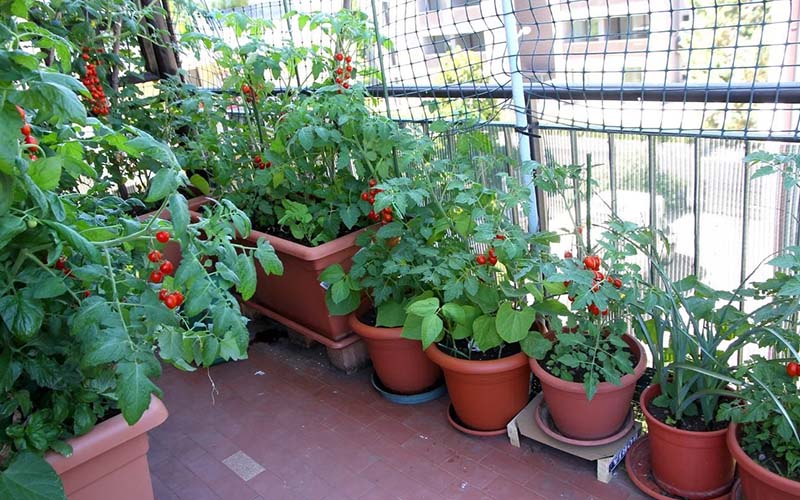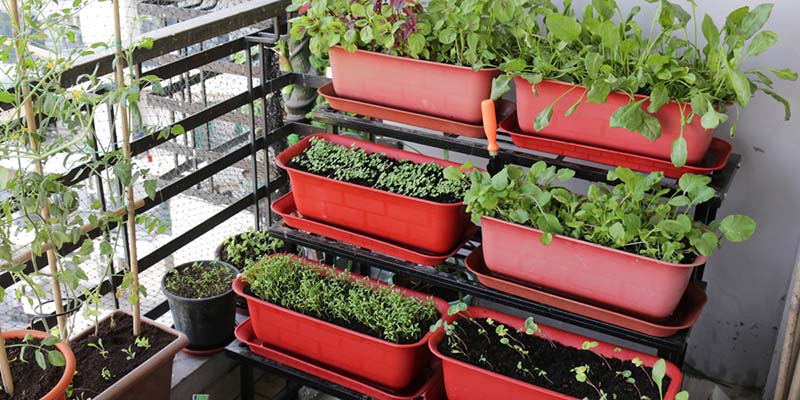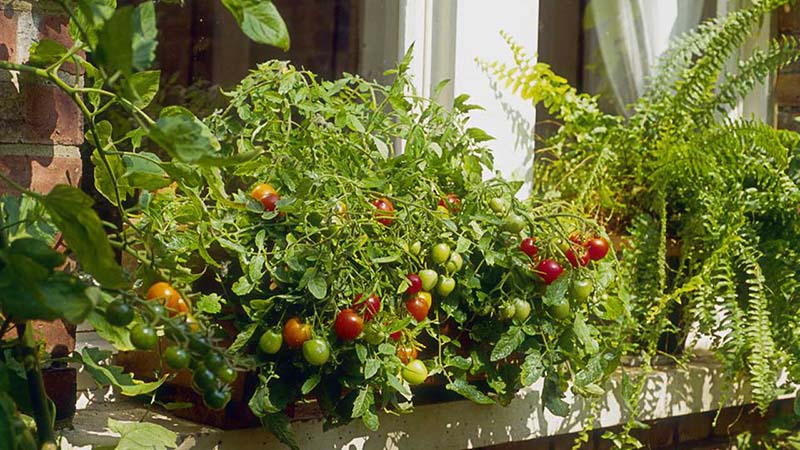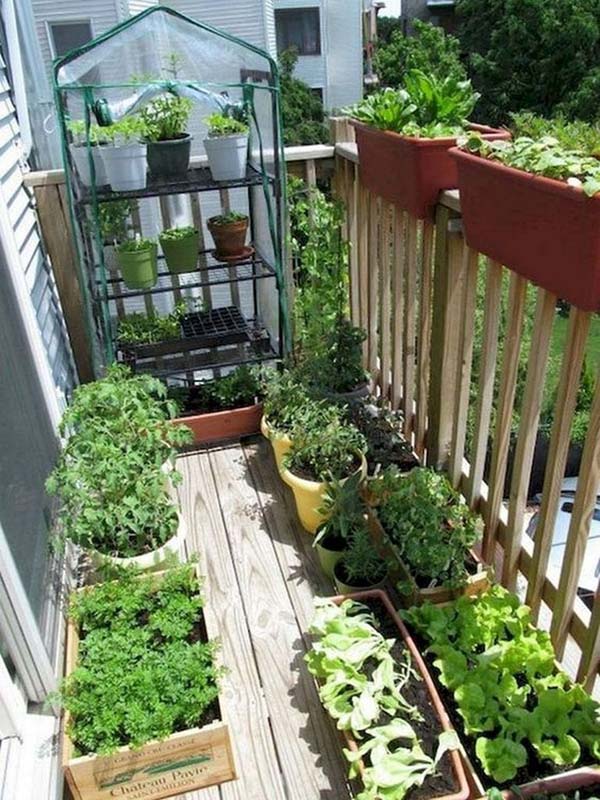Living in an apartment does not have to imply a lack of greenery. Apartment gardening on a modest scale may be rewarding and pleasurable. Experts will appreciate focusing their attention on a few of the more exotic and intriguing species, whilst novices will benefit from learning about some stunning, easy-to-grow plants that will help them find their green thumb. Let’s have a look at some urban apartment garden ideas.
Ideas for Urban Garden Apartments
Apartment gardening is not difficult even for beginners. Patios and balconies are excellent locations for growing plants in apartments. Before you go out and buy plants, have a look at how much sunlight your area gets. Full sun is defined as eight hours of direct sunshine every day. The partial shade lasts four to six hours, whereas shade lasts less than four hours. Examine the area in the spring or summer, when all the surrounding trees and shrubs are in full bloom and select plants that are suitable for the quantity of light available.

White and pastel flowers are best seen at night, but rich blues and purples require sunshine to exhibit their true hues. Consider planting plants that produce their aroma at night, such as nicotiana and moonflower, if you prefer a pleasant aroma. Choose plants that grow up rather than out for tiny areas. Bushy plants soften the look of the patio, but they take up a lot of room. For small spaces, use plants that are columnar or pyramidal.
One of the most optimal indoor garden ideas for small apartments is the creation of a windowsill garden. Because of the limited area, windowsill gardening generally requires growing little plants in small pots. This will inevitably limit the size of plants you can grow.
Edible Plants to Grow in an Apartment
To some extent, you can grow almost any plant in a container. A full-size apple tree, for example, would be out of the question, but there are slim columnar kinds that can fit on a one-square-foot balcony corner. Consider what you like to eat, and then pick a few other types of plants to try. Start with seeds, which provide greater diversity and are less expensive. Small nursery plants, on the other hand, will help establish your garden in the apartment more quickly.
What about an Apartment Herb Garden
Herbs are an excellent alternative to plant in your apartment because they don’t take up a lot of room and are often aromatic. If you enjoy cooking with herbs but can’t afford the high prices at the grocery store, basil, mint, cilantro, parsley, or even ginger are all excellent choices. The majority of herbs are simple to grow. Simply choose a sunny location and remember to water regularly.
Growing Vegetables in Apartments
How about growing food in an apartment? If your apartment has a sunny balcony, then this is a great reason to create a small vegetable garden.
Among the best vegetables to grow indoors, tomatoes are worth highlighting. Growing tomatoes in an apartment may be quite difficult, yet they thrive in containers. They’ll thrive in a container with a diameter of at least 14 inches, but the bigger one is preferable. Patio variants may be grown in a hanging basket. Make sure you choose a dwarf or determinate variety of tomatoes for your apartment patio vegetable garden.
Peppers can be a wonderful and most importantly healthy addition to your apartment vegetable garden. If you enjoy the heat, you’ll enjoy cultivating them. Peppers are tropical perennials, which means they thrive in hot climates and lots of sunlight. They need between 6 and 8 hours of light every day, and the room temperature should be approximately 70 °F.

Because peppers, like tomatoes, are self-pollinating, they thrive inside. Allow your soil to dry out between watering and make sure your container is at least 8 inches tall. Your peppers may bear fruit throughout the year and will complement your apartment vegetable garden with tasty and healthy fruits!
Another vegetable you can grow in an apartment is a kale plant. Kale is a delicious and nutritious vegetable that also happens to grow well in small spaces.
Growing kale is similar to growing tomatoes in that it simply requires:
- a 6-inch square pot
- fertilizer
- irrigation on a regular basis
It’s important to remember that kale has to be watered regularly. Also, keep the kale container in the shade throughout the summer months because the sun might harm the leaves. Kale is a great idea for balcony vegetable gardening for beginners.
Well, how about scallions? Scallions are a reusable plant, so you won’t have to keep sowing seeds if you run out. Simply remove the green portion and place the white bulbs in a small cup of water, where they will re-grow in a few days. Simple, quick, and space-saving! Scallion is an excellent vegetable to keep on hand in your apartment garden.
If you love garlic, consider growing it in your apartment veggie garden. Garlic greens taste similar to spring onions and can easily be grown in a small four-inch pot with three to four garlic cloves. Put the pot on a sunny windowsill and water lightly.
Growing vegetables indoors in your apartment is a great idea to save money and grow wholesome and healthy fruits!
What Fruits Can Be Grown
Fruit requires a little more effort to grow in an apartment garden, but it isn’t impossible. Dwarf citrus trees that produce lemons or limes may be grown in your flat, but fruit development takes years. Some purchase fruit-bearing plants and then continue to cultivate and maintain them for the following year. Add a garden box to your windowsill if you have a bright window to produce fresh strawberries for a summer salad or mixed drinks.

Another fruit you can grow is an avocado. To grow an avocado, all you need is an avocado. Save the large spherical pit in the core of the avocado after you’ve finished eating it. After rinsing the pit, insert four toothpicks into the base and dangle it over a glass of water, with the bottom in the water and the tip above the water. Place the glass on a brightly lit windowsill and make sure the water level is maintained. Roots will have developed from the pit in a few weeks, and they will be ready to be placed in a pot of soil. Once the seed has been sown, set the pot in the sun and water it softly but often.
Microgreens for Apartment Farming
Microgreens are little vegetable greens gathered after the cotyledon, or embryonic section of the seed begins to sprout. Microgreens, unlike traditional vegetables and herbs, maybe harvested in just a few weeks.
Potassium, magnesium, copper, and important antioxidants are all present in these pint-sized greens. Some enterprising renters even develop microgreen side businesses from their residences.
Apartment Garden Care
In your indoor apartment garden, you may anticipate performing the following duties daily:
- Watering: It is by far the most crucial aspect of gardening. Even if your garden receives rain, it will most likely be insufficient. Container soil dries up rapidly, especially as your plant matures. Poke your finger an inch or two below the surface of the soil to test it. You should water it if it seems dry.
- Feeding: You’ll need to feed your plants regularly, depending on their specific needs for growth. The simplest technique is to use a water-soluble fertilizer that may be applied when watering. Also, check to see whether your potting mix contains fertilizer since this will usually postpone the need to feed your plants.
- Problems: Pests and illnesses make their way into plants no matter where they are grown, and insects have no natural predators indoors. Whenever you water or harvest your plants, look for issues. If you see evidence of pests or diseases on a plant, such as discoloration or holes in the leaves, remove it from the rest of the garden until the problem is resolved.
- Harvesting: Figure out when your unique plants are ready to be harvested and then don’t wait to reap the benefits of your effort. Harvesting can sometimes encourage the plant to grow even more food for you to collect.
Selecting Containers for an Apartment Gardening
One of the best things about tiny indoor gardens for apartments is how inexpensive it is to get started. You don’t need to buy planting containers; instead, think about:
- To start your seeds, use toilet paper tubes or other waste materials (eggshells, newspaper, or other scrap paper folded into little pots).
- Making homemade propagators out of transparent plastic. When germinating seeds, clear plastic trays, tubs, or bags used for food packaging can be placed over seed trays or pots to provide a little more heat.
- Using food packagings such as yogurt pots and plastic trays.
- As containers, use plastic drink bottles were used. You can use old cooking equipment or other upcycled objects.
- Making shelves or vertical garden structures out of upcycled furniture or wood pallets.
- Obtaining free (or low-cost) vintage equipment, pots, and gardening supplies over the internet.
Now that you have learned what to plant and how to care for them, we want to give you a couple of tips on how to have a garden in an apartment to make this experience a real joy.
Apartment Gardening Tips
Map Out Your Space

For successful apartment gardening, you must first map out your space. Identify spaces where you may install or hang structures for your plants, such as bookshelves. You’ll also need a way to drain your garden once you’ve watered it, so make sure your sink is big enough or that you can reuse enough lids and plates to put below your pots and planters. Don’t forget about lighting as well and choose locations close to windows as this gives more room for apartment gardening.
Start with Succulents
Succulents are essentially maintenance-free plants that can grow inside an apartment with enough light, regardless of temperature. Aloe vera is a fantastic alternative for soothing kitchen burns. Try growing your first plants as a novice with a Zebra or Panda Plant.
Consider Your Schedule
Even the simplest plants require time to properly care for. This should be given special attention before you start a garden in an apartment. Choose plants that will thrive in the amount of time you have to commit to your new garden. If you have a hectic work schedule and a fast-paced social life, choose low-maintenance plants. Growing high-maintenance species might be difficult, but it can be extremely gratifying for homebodies and freelancers who work from home.
Make the Most of Your Lighting
You’ll be able to cultivate a broad range of houseplants, such as cactus, succulents, and tropical flowers in your apartment garden if you have many windows and plenty of hours of direct sunshine.
Utilize Your Window Ledges
Window ledges may be used to store long rectangular planters and miniature pots for a small apartment garden, and they take up precious real estate in your apartment. It’s vital to choose plants that thrive in full sunshine, but make sure they’re turned away from the glass so they don’t grow in the direction of the sun.
Use Your Resources
Even seasoned gardeners review the care instructions supplied with their plants to verify that the watering, soil, and sunshine needs are met. Furthermore, the internet provides limitless knowledge on how to care for your plants based on their species and the environment in which they live. Also, don’t forget to check how long indoor plants live. Because not all houseplants have the same lifetime, it’s important to know how long you’ll be caring for yours.
Consider the Humidity
Greenhouses aren’t just for balconies and rooftop patios. They may also be used to assist plants to thrive in an apartment with a low humidity environment. Some plants, such as dracaena, begonias, and ferns, thrive in moderate to medium humidity.
Apartment gardening should be enjoyable rather than a job. If you’re short on time, there are many gorgeous plants to pick from that require minimal care. If you’re looking for a challenge, there are lots of different plants to choose from. Above all, pick plants that will grow in the circumstances of your apartment garden, as well as plants that will look nice, fit well in the area, and appeal to you.


